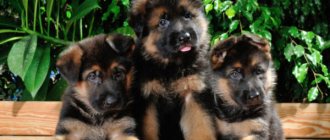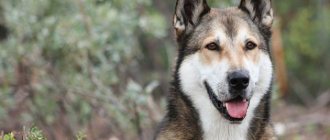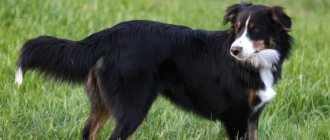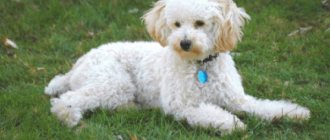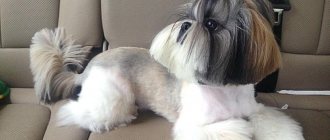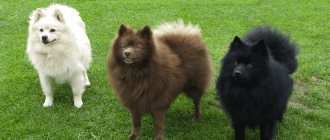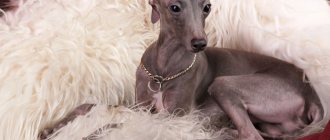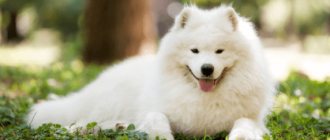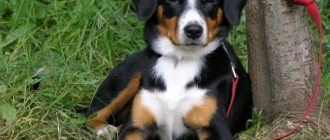The existing German Shepherd breed standard is designed so that the dog has good working qualities. This is achieved by a harmonious combination of body parameters. Another challenge is character. At the exhibition, dogs with unstable psyches are mercilessly culled.
German Shepherd breed standards
The appearance of the herding dogs from which the shepherds came changed over the years of breeding the new breed. The size of an adult German Shepherd differed among different breeders, and other parameters also did not stand still. The first animals had nothing in common with modern dogs. The magnificent Horand von Grafarth, who was the first to be included in the breed register, would look more than modest today compared to the beauties of the ring.
Exhibition parameters differ slightly in different countries. American German Shepherds have such a “steep” back slope that the animal seems to be sitting all the time. Working group dogs are not like factory dogs. They have fewer folding requirements. In addition, the breed continues to improve; it is sometimes difficult for experts to choose the ideal dog, since compliance with the parameters does not always result in a completely harmonious dog.
Description and standard
The German Shepherd acquired its description of the breed only in 1991, the standard has changed over the years, brought to ideal, acceptable indicators, but has not suffered significant changes.
Males and females have a clear external difference based on gender, the female is more miniature, and the males are predominantly powerful, heavy and large. Girls are more mobile, but less bulky, which allows them to have the greatest speed, while they are more often taken into service workers, due to their better obedience.
- Height at the withers and weight for an adult male German Shepherd: 58 – 67 cm, 35 – 45 kg;
- Female: 53 – 62 cm, weight – 25 – 35 kg.
- Head: powerful, wedge-shaped. Wide forehead, erect ears, hard cartilage. The ears have a black edging, along with the earlobes. The frontal bones of the skull protrude slightly, the dividing groove is not pronounced.
- Jaw: powerful, elongated, proportional. The lips fit tightly and have full color. The bite is correct, scissor-shaped. The teeth are large and complete.
- Body: heavy boned, powerful, large-type body, elongated, smooth transition into the line of the tail from the loin. The back is not short, it goes down a little, forming an angle.
- Neck: powerful with good muscles, not short, wide.
- Chest: developed, oval. The shoulder is not short, but straight.
- Limbs, paws: straight, without inversion, parallel to each other, with good muscles. The hindquarters are much stronger, the thigh is wide. The shoulder and shoulder blade are almost the same length, the tail is saber-shaped in a free state - at the level of the hock joint. The paws are compressed into a tight ball, the claws are strong and black. Movements are not constrained, fast.
There should be no folds on the body, predominantly dry muscles, color strictly according to the standard. Deviations do not mean that the dog is not able to live a full life, but difficulties are possible.
German Shepherd - does not meet the standard and description of the breed, cannot participate in exhibitions or breeding, the following defects include:
- Short loin;
- Slanted croup;
- Long shoulder;
- Extended lower back;
- Tail crease;
- Don't paint over it;
- Deviations from the standard in height, along the lower limits;
- Absence of testicles in the scrotum in male dogs;
- No mask on the face;
- Misalignment of the jaw, incorrect bite;
- Inverted paws;
- Insufficiently strong skeleton;
- Short neck;
- Mental abnormalities - aggressiveness, cowardice.
Many of the representatives do not have a typical color, but are harmoniously built in appearance; they are usually not allowed for breeding, but if the deviations are not significant, then they can be improved with well-planned mating. For each breeder, the categorical choice of breeding females and males is different.
The German Shepherd has its own weight, which is most comfortable for it; if the animal gains excess weight, problems with the joints and spine begin; these are fairly light dogs, despite their external power.
Varieties
The German Shepherd - during its history, has collected many types of foreign blood, some remained in high esteem, others were preferred to be removed from breeding. Today, there are different types that exist within the same breed and are varieties, not individuals.
- West German is the basis of the breed, ideal parameters according to the standard.
- East German - larger in build, appeared after the Second World War.
- Belarusian - black, exclusively for service. The color is only dark, black if you like. The largest German Shepherds can reach 85 cm at the withers.
- Longhair - has no official recognition, but is widespread and beloved among fanciers, sold under the guise of an Old German representative.
- Miniature, dwarf - is not a separate category, has a more miniature size that does not reach the standard, and is no different from ordinary Germans, except for size. Performance characteristics and basic character traits are fully preserved.
Color
The coat has a dense hair structure, with a good undercoat, shedding occurs 2 times a year. Color can vary, the gray German Shepherd is the most common of all.
The German Shepherd and its species are divided into smooth-haired individuals and long-haired individuals, which are distinguished by long hair. For all representatives, the thickness of the body is almost the same, but on the neck, hind and front legs, and tail - it should be slightly longer and furrier
Mini German Shepherds of zonal color look very attractive. Black color is the most preferable color for a German Shepherd.
A variety of colors from black - gold, smoky, gray - blue and yellow, deep brown and ash - gray. Dogs that resemble a wolf in color, gray-blue with black, look very beautiful.
The German beauty is a standard type, exclusively short-haired, although representatives can be found with different lengths.
Head of a purebred dog
The head of a German Shepherd resembles that of a wolf. Large erect ears, an elongated muzzle of a shepherd like a forest predator. At the same time, males and females differ in the expression of their muzzle. The male dog has an imperious and courageous look, like the leader of a pack. Bitches have a more gentle facial expression.
According to the standard, the skull of a purebred dog has the same length and width. The ratio of the length of the skull to the muzzle is 1:1. The main parameter is the parallelism of the facial and cranial axes. If you place one palm along the muzzle and the other on the dog's brow ridges, then the palms should be parallel.
Shepherd eyes
The dog's eyes have a semi-lateral position and are dark in color according to the standard. The darker the eyes, the better. But only dogs with yellow eyes are rejected, as it makes the expression of the muzzle cold and distrustful.
Ears
Prick ears are wide at the base, pointed at the top, and set high on the skull. Puppies have drooping ears and can stand up from 4 to 8 months, and this is not a matter of concern. It's worse if the baby starts holding his ears too early. This indicates a weak animal whose ears are too light.
Teeth
The animal must have a full set of teeth and a scissor bite. An overbite, underbite or overbite is rejected. Dogs with partial teeth are also eliminated.
How to choose a puppy
Initially, find out as much information as possible about the parents, study the pedigree, look at the mother's diseases and look at the bitch's litters. Decide on a breeder in advance and look at the babies.
Shepherd puppies are delivered to a new owner at 2-3 months, with a full set of vaccinations.
Kids should be active, inquisitive, and not hide in a corner or hide. They are funny and cute, a little like chubby bear cubs.
How much does a puppy cost?
The cost starts from 25 thousand for a pet category puppy, show class - from 30 thousand rubles. The more awards and titles the parents have, the more expensive the puppy is; if his parents are world champions, then get ready to pay about 1000 euros.
Babies that are not planned to be used in further breeding, but are given away as a pet class, are much more expensive than brothers and sisters.
Dimensions of a German Shepherd
The German Shepherd should have an elongated body. Her torso should fit into a rectangle. The body length can exceed the height at the withers by 10-17%. In this case, the back has a slope towards the pelvis. The front is higher than the back. This is due to the fact that the impulse during running is transmitted from the rear. One of the characteristics of the Shepherd is endurance, so the body and limbs are an ideal mechanism for easy trotting.
Neck
The neck should be 35% of the dog's height at the withers. Ideally, the neck axis has an inclination of 45 degrees. to horizontal and 90 degrees. to the shoulder. The neck circumference of a German Shepherd is not a standard measurement, but can vary. Approximate figures 50-55 cm.
Breast
Chest parameters are rarely measured at exhibitions. An inspection is usually sufficient. The average chest circumference of a German Shepherd is 85-89 cm, but this depends on the proportions of the dog. The depth of the chest and its width are taken into account.
Shoulder to forelimb ratio
More recently, the ideal angle between the shoulder blade and the shoulder was 90 degrees, but such parameters were impossible to achieve. Now an interval of 98-110 degrees is allowed. The inclination of the scapula and shoulder to the horizontal line matters. The shoulder blade should have an inclination to the horizontal of 54 degrees, and the shoulder - 55-60 degrees. A straight, long shoulder is valued in the ring.
The role of the back in the movement of the dog
The high withers are sloping, this provides traction to the back, which helps transmit momentum during movement. The back is long, formed by 8 vertebrae, and has developed muscles. This is the conductor of the impulse of movement. The loin is short and wide. It connects the back to the back pushing part. The sacrum is long, wide, and muscular. Almost all the muscles involved in movement are attached to it. Its inclination to the horizontal is 27-31 degrees.
The role of the hind limbs
In the hind limbs, the tibia and shin bones should be positioned at an angle of 120 degrees. in relation to each other. This is the optimal ratio at which the dog can move easily and evenly. A more obtuse angle will not allow you to take a wide step, and a less obtuse angle will reduce the strength of the limb.
Tail
The tail has many functions:
- protects the genitals and anus;
- acts as a means of communication;
- acts as a steering wheel.
According to the standard, the tail should reach the ankle; in modern dogs it is usually longer. Some dogs have to hold their tail up to prevent it from dragging on the ground. A violation is considered to be a tail that is “attached” too low.
Personality of the German Shepherd
For the German Shepherd, not only the exterior is important, since it is a service dog. If at first she was only a shepherd, then later “versatility was invested in her.” The Shepherd is a “jack of all trades” service dog. She must be hardy and tireless, well trained. The pet must have ideal contact with humans and be able to make independent decisions. For many years, there was a strict culling of dogs with unstable psyches.
The German Shepherd ring is a special spectacle. The dog must demonstrate its best qualities:
- Features of temperament and threshold of excitability. How quickly the animal reacts to stimuli.
- Search work. How an animal can pick up a trail.
- Protection of the owner, property and territory.
- Fighting qualities. How much does a dog like to fight?
- Confident behavior in stressful situations.
- Distrust of strangers and objects.
- Endurance and perseverance. Work in any situation.
- The dog must be able to show courage and observation, be attentive and make independent decisions depending on the situation.
Untrained dogs that cannot follow commands are rejected. Nervous and cowardly dogs, pets that show aggression and do not have sufficient contact with the owner receive refusal.
Character
The character of all German Shepherds is a gift to a person. There is no more loyal and intelligent dog capable of becoming a family favorite. Possession of such qualities as: vigilance without aggression, understanding a person on an emotional level, obedience, lack of stubbornness, achievement of a set goal - made her one of the best representatives in the canine world.
Possessing a sharp mind and good memory, she is able to remember a huge number of different commands. He always tries to please his owner and has a hard time when he is angry or dissatisfied.
- I'm glad for his attention and loves games. She is friendly and sociable, does not show excessive intrusiveness, sincerely respects and loves.
The German Shepherd is predominantly a boy and has a tendency to dominate, so conflict situations may arise with other dogs.
- An active dog that requires good physical activity that develops intellectual programs.
Excellent guards who are always ready. At the same time, dogs do not have the peculiarity of showing aggression, but they are capable of making independent decisions without the presence of a person.
- They have a hard time with the absence of their owner and may feel sad. They have an instructive attitude towards acquaintances and family friends, and calmly accept new people and animals into the ranks of loved ones.
Easily adapt to different living conditions and climates. They are emotionally stable, but sometimes, if there is not enough communication or walking, they can behave extremely excitedly.
Compatibility with small children
The German Shepherd is a loyal friend to a child and is not capable of causing pain or showing aggression. The only thing worth remembering is that small children may often not fully realize that they are causing inconvenience to the dog.
Initially, it is necessary to explain to the baby what can be done with the animal and what should be abandoned. At first, when the puppy is growing, it is important to form a relationship so that the pet understands that the little person is also his master.
The best option would be to go through a training program with a professional, where you can learn how to properly handle a dog. After the dog grows up, it can be safely left with the baby.
The intellectual abilities of a German require constant maintenance from the owner; educational games, intuition tasks, and search games are suitable.
There are educational toys special for dogs when they need to find something or express themselves in some action.
Show dog and its condition
Having got an ideal pedigree dog, you may not get a good mark at the show. Education and training are only one part of the job. The dog must have the correct constitution, that is, normal grooming and fatness. A well-fed pedigree dog will not receive a good grade, just like an emaciated one. The condition of a pedigree dog, as a rule, differs from this indicator of an animal of working breeding. The latter may have a thinner layer of fat. Working dogs are not assessed by conformation at all, since their success in competitions is important. They are used to evaluate the dogs in this ring.
The two branches of dogs have been bred since the time when the kennel owners themselves split. Some focused on beauty, others on reaction speed and endurance. At the same time, pedigree dogs still did not become decorative sissies.
Nutritional Features
When feeding your German Shepherd, you need to consider the ratio of proteins, fats and carbohydrates. Most of all should be meat, then come vegetables and grains, and only then vegetable or animal fats.
CAREFULLY!
German Shepherds should not be fed pasta, long bones, baked goods, flour, legumes, spices and canned foods.
You need to feed your dog twice a day at the same time. The food should not be too cold or hot, it should not contain excess liquid, and the meal itself should not last more than 20 minutes.
The best meats are turkey, beef, sometimes add lean pork . Beef bones and not tubular bones are also suitable, but they should be given when the dog is already full.
Buckwheat, oatmeal or rice are suitable cereals. It is allowed to give the dog raw or poached eggs several times a week.
Offal products are also suitable for feeding puppies . Calcined cottage cheese is also important for them.
Violations in the standard
Why a dog can be rejected, for example, for improper behavior in the ring. Aggressive behavior towards judges or other dogs, cowardice or disobedience may result in disqualification from the show.
Dogs with cryptorchidism are screened out based on physical parameters. Moreover, one of the conditions of the standard is pronounced sexual characteristics.
It is important that the height at the withers of a German Shepherd does not exceed breed standards.
A dog that is overweight or has a loose body structure is also not suitable for exhibition. Incorrect proportions as well as insufficient height of the shepherd at the withers are signs of a violation of the standard. Too light or heavy bones, long or crooked legs, a docked tail will not allow the pet to compete with its fellow tribesmen.
Culling can also be carried out based on the following criteria:
- too light coat color or incorrect pigmentation;
- malocclusion or missing teeth;
- inappropriate muzzle parameters;
- soft or floppy ears;
- bifurcated or unpigmented nose.
Dogs with defects and defects are not allowed for breeding.
Owner reviews
- Marina, 40 years old, Stavropol
I wanted to have a German for a very long time, but I was afraid that I wouldn’t be able to cope with him. Recently we decided to adopt a male dog, we took it from the breeder at 2 months, I carefully watched the puppy. The weight and height of a German Shepherd by month are easy to track, but nutrition was problematic.
First, start eating natural food, but we realized that the baby couldn’t handle it and began to lose weight. It was decided to transfer him to food, as the breeder advised, so that’s what we did. All problems with stool and allergies immediately disappeared.
- Oleg, 34 years old, Sevastopol
I'm a policeman, Gretta serves with me. This is an ideal animal, smart, patient, quick-witted. I never thought that I could become so seriously attached. Always confident days, I know that he will never let me down.
Share link:
German Shepherd Standard RKF
Russian breed standards have undergone no less changes than the German Shepherd itself over the entire period of its development. The first influx of dogs coincided with the German “crisis of overproduction” of service dogs in Germany in 1923. The specimens brought into the country were not of the best quality. The Great Patriotic War greatly “thinned out” the breed, and politics finally stopped its development in the USSR. Large East European Shepherds, created on the “scraps” of breed material, were far from the harmonious “Germans”. Their own breed and lack of contact with the former enemy put breeding work at risk.
The first purebred dogs were obtained secretly, across several borders. The breeders risked not only their reputation, but also their lives. Breeding German Shepherds was considered treason.
The first stream of German Shepherds of average quality poured out of the GDR
In the 70s, the socialist countries abandoned the eastern standards of German shepherds and switched to western ones. Unwanted animals were sold cheaply to the Soviet Union. Only in 1989 did the USSR adopt international standards for German shepherds.
Breed standards answer the question of what size German Shepherds should be and what they look like. The priority for dogs of this breed should be harmony, both in appearance and behavior.
